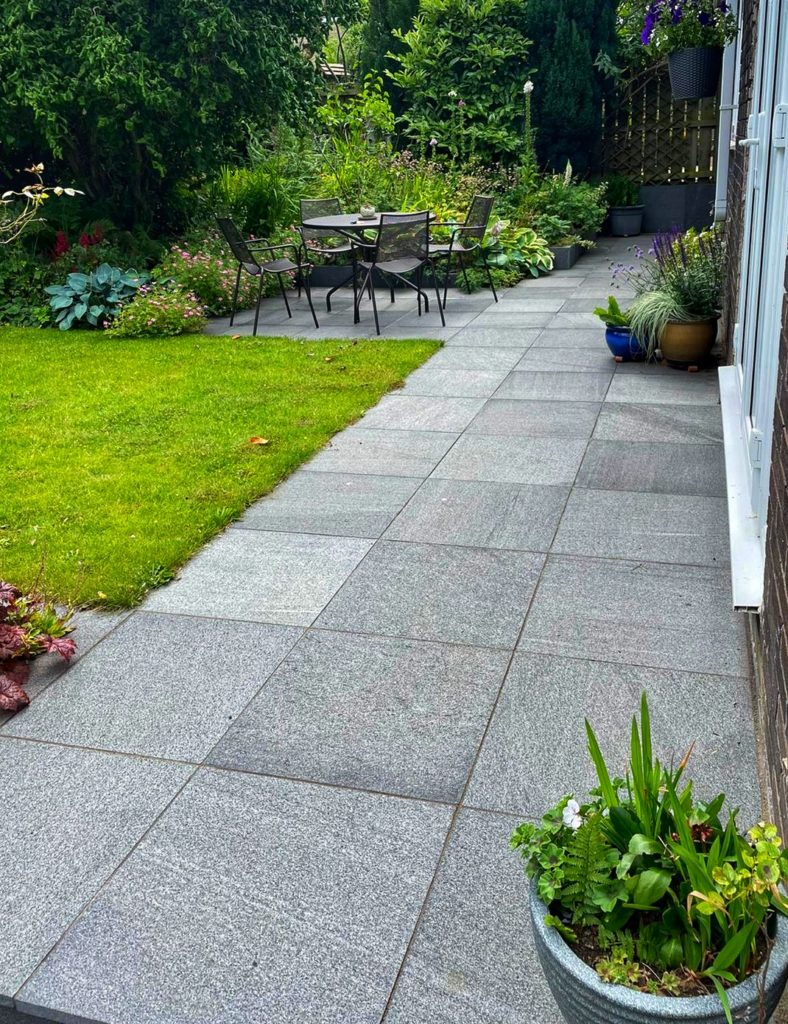This is a tricky question to answer. A better one would be, ‘Which patio slabs are best for me?’ So many things can influence choice of a product; quality, price, availability, carbon-footprint, ethical sourcing, etc. Everyone will have different priorities and preferences as to what is best for them and their garden.
There is a huge selection of paving out there and it’s difficult to compare like for like as individual companies have different brand names for the same type of product. Looking at a supplier site can feel overwhelming, more so if you don’t understand what you are looking at.
The technology in manufactured slabs and natural stone has leapt forward in recent years. Paving now is produced for the best quality finish to last for the maximum amount of time (most manufacturers guarantee their products for 25 years). This comes at a premium, however, and top-quality paving can run into the thousands before you have even broken earth. How can you make sure you are getting the best value for your money and not being ripped off?
Here at T Jeffords we have been able to break down the paving options on the market now into roughly 4 categories to make it easier to understand the paving products available and the benefits of each.
1. Concrete-pressed paving
This will always be your cheapest option and is exactly as it sounds. Concrete is poured into a mould which then hardens to produce a slab. The paving therefore will be a uniform size, shape and colour. This makes it quicker to lay and so saves on time.
Don’t panic if you are imagining great, grey slabs of concrete! Modern options come with textures and colouring that that imitates natural stone, and with a creative layout design concrete paving can look impressive.
As a man-made product, concrete is more durable than stone and will weather better.
Because each slab looks the same, the finished look will regular and undeviating. It will look neat, but without the unique charm of stone.
2. Indian sandstone
This hard-working product deserves a category all its own. If you haven’t heard of it, you will definitely have seen it. Indian sandstone is hewn, which means it retains its bumpy (riven) texture where it has been cut from the quarry. Sold in ‘multi-packs’, different sizes and colours are laid in complementary, random patterns rather than uniform rows, providing a unique layout. The slabs are calibrated to the same depth and to specific sizes, so the patio layout fits together and flows naturally.
Indian sandstone is one of the most popular paving choices in the UK. This is because it is so versatile and competitively priced for a natural stone.
It’s imported from India, so has a larger carbon footprint than stone sourced in the UK. There can be questions around whether quarry workers have been treated ethically, and there can sometimes be discrepancies in quality. It’s worth taking the time to find a reputable supplier who is dedicated to ethical trading and will guarantee the quality of the product.
The riven finish of the paving means the finished look of the patio will be traditional, or rustic, rather than modern. As it’s a natural product each slab will be unique and subject to slight variations of colour and texture, which is of course the whole point of natural stone!
3. Premium Natural Stone
This is a broad category and includes many types of stone, the most popular being Sandstones, Slates, Granites and Limestone. There are two main textures of natural stone; slabs can be ‘riven’, which is where the natural, bumpy texture of the slabs is left alone after they have been hewn from the quarry, or they can be ‘sawn’, which means the surface has been smoothed down flat.
Both riven and sawn products will be subject to small variances in size, texture and colour. The slabs will look different when wet to dry. Often natural stone is sold in ‘multi-packs’ and different sizes will be laid in complementary, random patterns rather than uniform rows.
Because of the variety of natural stone available on the market prices will vary but will tend to sit at the higher end of the market. Installation will be more expensive too, as natural stone paving takes slightly longer to lay. Cuts in the slabs may be required, so more would need to be purchased to account for this.
There is much greater choice than concrete slabs or Indian sandstone. Individual slabs will be unique and subject to slight variations of colour, grain and texture, making for a stunning finished patio.
4. Vitrified paving / Porcelain
Vitrified paving slabs are ceramic tiles. They are made using clays that are fired to a very high temperature to create a hard and durable finish. The flags are very hard to scratch. They also have a lower rate of water absorption, providing exceptional resistance to stains and growth of moss and algae.
As a man-made product, porcelain slabs will usually be a uniform size and have a smooth texture. More variety of colour and size is available than natural stone, and special effects can be baked into the tile, such as a metallic finish or imitation wood grain.
Prices will tend to be at the higher end of the paving market. It’s also more expensive to install, as the product is brittle until laid and needs extra care when cutting.
The finished look will be contemporary, modern and sleek.
As always, whenever you decide to have gardening work done make sure you find a reputable contractor who has proven experience of designing and installing landscaping and will guarantee their work.
T Jefford Garden Services Limited has been providing outstanding garden solutions for 18 years. Our dedicated team are ready to help turn your ideas into reality.



